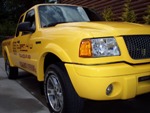 Dislikes: 0
-
Help: Rotary Buffer Use
I really want to learn how to use rotary buffers and am looking at buying one. My friend has a beater vehicle and has agreed to let me learn on it. I know quite a few of you use rotary buffers and was wanting some input surrounding their use. Are they difficult to operate? Are the results significantly better in comparison to those derived from DA machines? Are polishing times cut in half? How long does it normally take to become proficient with them? I'm particularly worried about burning the paint on the vehicles countours, such as on corners; what can be done to prevent this? Any tips, techniques, opinions, etc would be greatly appreciated.
-
Super Member

Last edited by justin_murphy; 12-01-2007 at 02:21 AM.
-
SELF BANNED

Rotary common mistakes and usage tips -
- Nearly every rotary on the market today uses a 5/8 - inch / 11pi arbour spindle for backing plates. I would recommend getting a hook and loop (Velcro™) backing plate Clean your pads before you use them, or start out with a new pad; use a soft toothbrush for foam, and a spur for wool. As a general rule, the more aggressive the polish, the more often you'll need to clean out your pads. I clean out my pad after every panel when compounding.
- Diminishing abrasives- you need to allow the abrasives to break down (become progressively smaller) to create a great finish or you may impart surface marring, holograms or worse. When a polish "flashes" from a liquid paste to a light semi-dry haze; its colour changes from the polish colour to almost transparent; the polish has then broken down and is ready for removal. It is important to know when a polish has broken down because if you take it too far you (dry polishing) will re-introduce surface marring. Conversely if you don’t work diminishing abrasives sufficiently they will cause surface marring; this is due to the size of the abrasive and its cutting ability, once an abrasive has broken down it becomes very fine and will burnish the surface as opposed to cutting it
- Ensure a ‘wet’ polishing film is always present between your pad and the surface. Swirls are usually caused by using an aggressive polish without breaking down the diminishing abrasives properly, or you may have used too much polish or it may have dried. To remove spritz the pad with distilled water (un-primed pads can cause marring) do not add further polish) and re-polish using the polish left on the pad.
- Edge (spin off) – a light sensitive approach is essential, using only the weight of the machine, on vertical panels just enough pressure to maintain contact with the surface (without applied pressure) tilt the contact edge of the pad a few degrees so that only the leading edge of the pad is in contact with the paint surface. A smaller pad surface contact area will increase friction heat so adjust machine speed accordingly
- Knowing when a polish is fully broken down comes with experience but a good yard stick is when the polish has gone clear and is very easy to wipe off. Holograms or micro marring are again imparted due to polish that hasn’t been properly broken down or too high speeds. Following the advice above or below should cure these.
- ‘Buffer hop’ is when the rotary jumps across the paints surface usually due to insufficient polish/lubrication and as the foam pad grips the paint it jumps. Try spreading the polish more evenly across the pad, add more polish, distilled water or quick detailer (QD) This can also be caused by a bogged down pad – clean / spur / replace pads often.
- For the neophyte user I would suggest starting out by using a smaller pad, 6.5 – inch I have even found 4- inch pads to be very useful for polishing small tight spaces and smaller panels.
- High RPM i.e. >1700 will cause high surface temperatures (should be limited to 1000F / 300 C)
- 1150F / 450 C < will damage clear coat to the point were it requires repainting.
- The HS Rotary requires no more pressure than that required to ‘hold’ it on the paint surface
- Always tape pinstripes; It doesn't take much to wipe them right off the paint, or thin them out
- Inspect your work under full sun (or use a 3M Sun Gun®) Holograms, fine marring hooks, etc. are very difficult to see under man made light. There's nothing more frustrating than having to strip off your LSP and re-do.
- Remove all polish residue and oils before applying your LSP. This is a general rule of thumb for best results across all product lines, and you will notice an overall improvement in the clarity, gloss, and overall 'look' of your finish.
- If you're new to rotary polishing start off by only using finishing pads and Do Not exceed
1500 RPM < faster is not better and it may cause you problems. Let the rotary do the work, you'll be surprised at what you can correct with a finishing pad and a mildly abrasive polish.
- When you shut down the machine never let the pad stop on the surface. Bring the machine to the closest edge of the panel and slowly let it roll off with an angle facing inward to the panel, this will help prevent marring.
- One of the biggest problems when using a rotary is product sling, however when using highly lubricated polishes splatter its a sign that you’ve used too much polish or you have turned the speed up to too fast, too soon. No matter how much you try and avoid it you’re still going to see it. When polishing cover areas you don’t want covered in product and mask off trim with blue painter’s tape if necessary and cover windshields or other vehicle parts with towels. Be careful around mouldings, antennas (aerial’s to us Brits ) and other trim pieces
-
SELF BANNED

Start off on a slow speed and do not use much pressure. This way you can start to judge your work. Just continue to go up in speed and a little pressure. I would go around and tape the edges to avoid burning them. Also find a car that you can actually see what it takes to burn the paint. Depending on the type of pad, foam or wool, you will need to see what it will take you as far as your technique goes to see how long it takes to burn the paint. Make sure you go with the curves in the body and also when you get to an edge ease up on the pressure and start bring the pad of the paint in a gradual movement. If I think of anything else I will add. Might have to go run the buffer over the hood to add to this. If you have any other question I will be more than happy to answer. All I use is a rotary.
-
 Re: Help: Rotary Buffer Use / Should Only Distilled Water Be Spritzed On Pad? Re: Help: Rotary Buffer Use / Should Only Distilled Water Be Spritzed On Pad?
 Originally Posted by TOGWT

- Ensure a ‘wet’ polishing film is always present between your pad and the surface. Swirls are usually caused by using an aggressive polish without breaking down the diminishing abrasives properly, or you may have used too much polish or it may have dried. To remove spritz the pad with distilled water...
Does added water really have to be distilled?
If so, what's the reasoning behind that?
-
Super Member

Re: Help: Rotary Buffer Use / Should Only Distilled Water Be Spritzed On Pad?
 Originally Posted by TomBrooklyn

Does added water really have to be distilled?
If so, what's the reasoning behind that?
First, I highly doubt that there would be any discernible difference between using a spritz of tap water vs a spritz of distilled. I can't imagine that the microscopic contaminants and minerals in tap water would have any negative effect in this instance.
Second, that was posted over 10 years ago which the pads and compounds have dramatically improved and there is FAR more lubrication in cutting compounds since that advice was posted. That said, the guy is seriously knowledgeable on the polishing process.
-
Post Thanks / Like - 0 Thanks, 2 Likes, 0 Dislikes
-
Re: Help: Rotary Buffer Use / Should Only Distilled Water Be Spritzed On Pad?
 Originally Posted by alko

I just read every post on this thread and man oh man I'm so glad the OP brought this topic up. This thread is full of great information. As alot of you guys know I just picked up a Flex PE-14 and I've had mixed emotions on using it. I still don't have pads, so I still haven't used it. I've been doing alot of research ever since I purchased the machine and as soon as I read something about burning paint I get nervous to even try it. But I'm sure with alot of patience, practice, and research I'll be fine. I really appreciate everyone's advice and suggestions-from old posts to new.
If you are nervous about burning the paint, work on a test panel and touch it with your bare hand. Feel how hot it gets. Get used to how long it takes to heat the panel up.
 Originally Posted by mwoywod

First, I highly doubt that there would be any discernible difference between using a spritz of tap water vs a spritz of distilled. I can't imagine that the microscopic contaminants and minerals in tap water would have any negative effect in this instance.
Second, that was posted over 10 years ago which the pads and compounds have dramatically improved and there is FAR more lubrication in cutting compounds since that advice was posted. That said, the guy is seriously knowledgeable on the polishing process.
You'd be surprised how "hard" the water can be in some places. I live in an area where the water comes out of limestone caves and the water is full of minerals.
Kirk Harrod's Mobile Detailing, Frankfort, KY
Official Detailer of Camarofest 8 & 9
No one has detailed more Camaros.
-
Post Thanks / Like - 0 Thanks, 1 Likes, 0 Dislikes
-
Re: Help: Rotary Buffer Use
-
Super Member

Re: Help: Rotary Buffer Use
This is an old thread that I'm reviving, as I see alot of folks, like myself, are getting into rotary polishers. Justin posted some good links...they're great reads and have some very helpful tips.
 Originally Posted by justin_murphy

Alex
...."Do the right thing...even when no one is looking"
-
Super Member

 's from everyone. Thank you guys for sharing. Very educational. 's from everyone. Thank you guys for sharing. Very educational.
Similar Threads
-
By Mike Phillips in forum How to articles
Replies: 17
Last Post: 06-17-2021, 08:13 AM
-
By Gcleov in forum Ask your detailing questions!
Replies: 4
Last Post: 01-20-2016, 02:35 PM
-
By HoldenFlinner48 in forum Auto Detailing 101
Replies: 33
Last Post: 08-03-2015, 02:12 PM
-
By jgraham37128 in forum Auto Detailing 101
Replies: 2
Last Post: 01-01-2014, 11:55 AM
-
By Sol on fire in forum Ask your detailing questions!
Replies: 12
Last Post: 12-26-2010, 12:03 AM
 Members who have read this thread: 2
Members who have read this thread: 2
 Posting Permissions
Posting Permissions
- You may not post new threads
- You may not post replies
- You may not post attachments
- You may not edit your posts
-
Forum Rules
|
| S |
M |
T |
W |
T |
F |
S |
| 28 | 29 | 30 |
1
|
2
|
3
|
4
|
|
5
|
6
|
7
|
8
|
9
|
10
|
11
|
|
12
|
13
|
14
|
15
|
16
|
17
|
18
|
|
19
|
20
|
21
|
22
|
23
|
24
|
25
|
|
26
|
27
|
28
|
29
|
30
|
31
| 1 |
|












 Thanks:
Thanks:  Likes:
Likes:  Dislikes:
Dislikes: 



 Reply With Quote
Reply With Quote
 's from everyone. Thank you guys for sharing. Very educational.
's from everyone. Thank you guys for sharing. Very educational.
Bookmarks